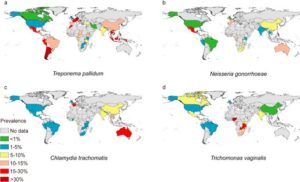Back to: MICROBIOLOGY 300 LEVEL
Welcome to class!
It’s great to see you here again! Today, we’re learning about three important bacteria that cause sexually transmitted infections (STIs): Neisseria gonorrhoeae, Chlamydia trachomatis, and Treponema pallidum. These infections are not just about medicine—they’re about people’s lives, relationships, and future health. In Nigeria and across Africa, these diseases remain a silent threat, especially among young adults. As a microbiology student, your understanding of these pathogens can help stop their spread and save lives.
Neisseria Gonorrhoeae, Chlamydia Trachomatis, Treponema Pallidum
Neisseria gonorrhoeae
This is a Gram-negative diplococcus bacterium responsible for gonorrhoea—commonly called “the clap”.

Transmission:
Through unprotected sexual contact—vaginal, anal, or oral. It can also be passed from mother to baby during childbirth.
Symptoms:
In men: Painful urination, pus-like discharge from the penis, swollen testicles.
In women: Vaginal discharge, burning during urination, bleeding between periods.
Many women show no symptoms, which increases the risk of complications.
Complications:
If untreated, it can lead to pelvic inflammatory disease (PID), infertility, and ectopic pregnancy.
Diagnosis and Treatment:
Identified through microscopy and culture or molecular tests. Treated with dual antibiotic therapy (e.g. ceftriaxone + azithromycin). However, resistance is becoming a concern.
Imagine a young woman in Abuja who keeps getting lower abdominal pain. She has no idea she has untreated gonorrhoea. After a proper diagnosis and treatment, her symptoms improve—and she avoids long-term complications.
Chlamydia trachomatis
This obligate intracellular bacterium causes chlamydia, one of the most common STIs worldwide.
Transmission:
Through sexual contact or from mother to baby during delivery (can cause eye infections or pneumonia in newborns).
Symptoms:
Often silent, especially in women.
When present: Discharge, burning during urination, pelvic pain, or pain during sex.
Complications:
Infertility, PID, and chronic pelvic pain.
Diagnosis and Treatment:
Detected using NAAT (nucleic acid amplification test). Treated with antibiotics such as azithromycin or doxycycline.
Think of a university student in Ilorin with no visible symptoms, but who gets tested during a school health campaign. She’s positive for chlamydia, receives treatment, and avoids serious reproductive complications.
Treponema pallidum
This spiral-shaped (spirochete) bacterium causes syphilis—a disease that progresses in stages.
Transmission:
Sexual contact or from mother to baby during pregnancy (can lead to congenital syphilis).
Stages and Symptoms:
Primary: A single painless sore (chancre) at the site of infection.
Secondary: Skin rashes, mucous membrane lesions, fever, swollen lymph nodes.
Latent: No symptoms, but bacteria remain in the body.
Tertiary: Can damage the brain, nerves, eyes, or heart years later.
Diagnosis:
Blood tests (e.g. VDRL, RPR) and confirmation with specific treponemal tests.

Treatment:
Penicillin injections remain the gold standard.
Imagine a man in Kano with a sore on his private part that disappears on its own. He ignores it, not knowing he has primary syphilis. Months later, he develops a rash—he finally seeks care and gets treated before it progresses to the dangerous tertiary stage.
Summary
- Neisseria gonorrhoeae causes gonorrhoea, often with discharge and pain.
- Chlamydia trachomatis causes silent but serious infections that can harm reproductive health.
- Treponema pallidum causes syphilis, which progresses in stages if untreated.
- All are preventable, treatable STIs that can lead to infertility and other serious complications if ignored.
Evaluation
- What bacterium causes syphilis and what are its stages?
- Why is chlamydia often called a “silent” infection?
- List one major complication of untreated gonorrhoea in women.
Every bit of knowledge you’re gaining is shaping you into someone who can make real impact. Keep up the commitment—you’re on the path to becoming the kind of microbiologist that brings healing, awareness, and prevention to the community. Afrilearn is proud to be part of your journey. See you next class!
